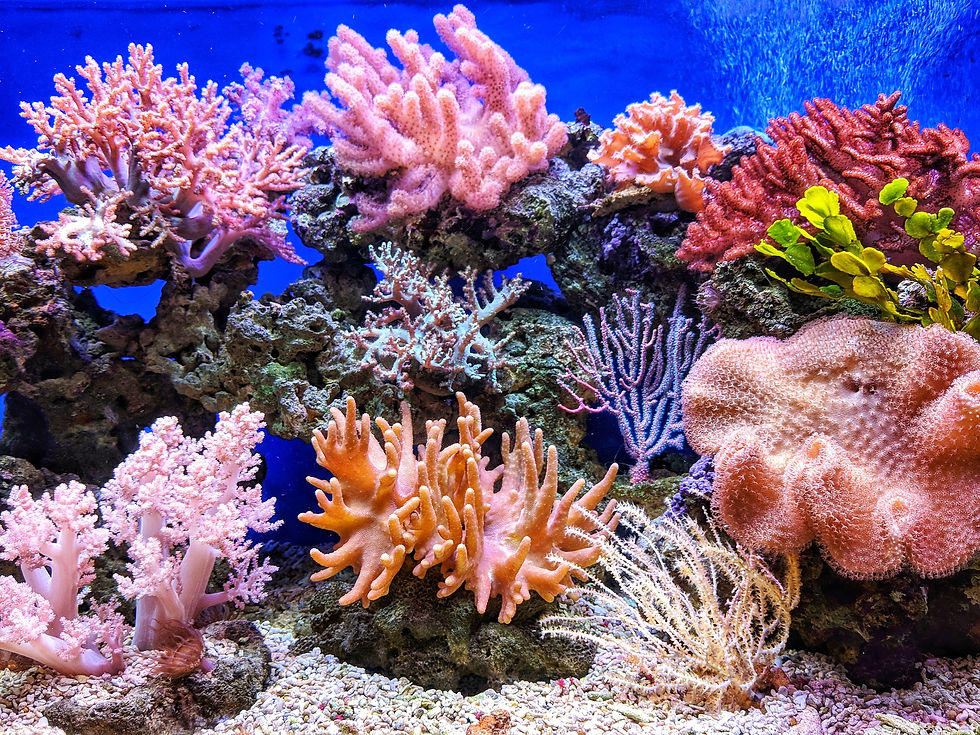Making Fashion Sustainable – 5 Ways to Preserve Oceans
- Lucy Stone

- Jun 16, 2021
- 4 min read
Updated: Aug 16, 2021
We all wish to do our part in making fashion sustainable. Yet, it is expected that there will be more plastic than fish in the ocean by 2050. With a multitude of factors contributing to this, the fashion industry is also taking its toll on the waters.
The high demand of ‘fast fashion’ has made increasing damage to our oceans, as the rapid production line leads to high levels of pollution and plastic, ending up in the oceans. For example, 17-20% of industrial water pollution is due to fabric dyes and treatments.
Not only has the demand for fast fashion increased, it has been globally extended. Globalised production chains have increased in scope due to production costs being much lower in developing countries.
Therefore, this creates more carbon dioxide emissions due to the need for transportation, as well as plastic packaging. The packaging is eventually thrown away and, consequently, releases into our oceans.
It is found that roughly 90% of clothing is shipped by container ship yearly than by truck to retail stores. This highlights the importance of both customers switching up their spending habits, as well as businesses having a corporate social responsibility in tackling this issue. Making fashion sustainable relies on eliminating poor practice as well as creating a good one.
1) Making Fashion Sustainable Through Packaging
When we hear about the damage to our oceans, the first thing that springs to mind is single use plastic. However, buying metal/bamboo straws instead of plastic ones isn’t quite going to reverse the effects. Major brands such as Colgate, TRESeme and others have completely reinvented their packaging to be 100% recyclable or compostable.
This has encouraged other businesses to follow suit as well as embed this onto an ongoing, almost ‘trendy’ marketing campaign. As more businesses jump on it, the more customers become aware of the importance of reducing plastic usage and, hopefully become willing to pay a few extra pennies to contribute to the campaign.
However, it is not just businesses that have their part to play within adapting their packaging. When shopping, it is important for us to be wary of our purchase decisions. For example, even picking up a bunch of loose bananas than packaged ones can go a long way.
If you feel a business is using unnecessary packaging that could easily be more sustainable, tell them! Small habits are integral in building a sustainable cycle. Yet, the cycle can only be created if everyone does their part.
2) Recycling Materials
Whilst we are doing our bit to find sustainable alternatives to plastic, it is crucial that these actually end up in our recycling bins!
Brands are also developing to make use of these recycled materials. For example, H&M have endeavoured to use only recycled or sustainable materials by 2030. Established shoe brands such as adidas have sought out to produce many different collections of trainers made of recycled materials from ocean waste.
Not only does this help to clear our oceans, it also reuses materials rather than making them from scratch. This means that there is less need for water usage, as well as harmful dyes. As established brands take stance, there is hope that the approach can be strengthened to, eventually, trend within the fashion industry.
3) Normalise hand-me-downs
Instead of throwing away old clothes, donating them to charity or selling them on various sites is a great way to act sustainably. With vintage styles becoming trendier, this is a great way to find hidden gems as well as reinvent our shopping habits to be more sustainable.
Shopping in charity shops has been growing in popularity in order to find dead-stock steals. This has branched out to apps such as ‘Depop’ and ‘Vinted’ that have grown to be extremely popular with a generation of people. Encouraging people to shop at these sites is a great way to eliminate fast fashion. Rotating old clothes reduces waste as well as earning you extra cash.
4) Reworking our clothes
Over the past year, lock down has allowed us to learn new hobbies. If our clothes become tired or a small hole appears in our jeans, the natural reaction is to throw them away. However, there are ample resources to teach ourselves how we can tackle this.
Even if this is covering it with a small patch or up-cycling it to a new top, the possibilities are endless. Nothing is thrown away! A new habit you enjoy could also come from it too – a win-win.
5) Reducing returns rate
As damaging as it is for container ships travelling across oceans to deliver our clothes, it is even more so with additional returns. 55% of respondents to a survey said sizing was their top reason for returning an item. As items are returned through shipping, more fuel and waste are released into the oceans.
To tackle this, fashion brands can question how they can make items appear more authentic online? Businesses could gather extra models that correspond to their sizing range. This means that, when a customer selects their size, the website shows a picture of a model who is the same size wearing that desired item. Consequently, the customer may have more of a visual picture of how they will look.
Although this may initially increase costs, in the long term the number of returns are likely to decrease.
We all have a part to play in making fashion sustainable. Fashion is thriving, yet our oceans are dying. Now more than ever, it is vital for everyone to play their part in tackling the issue we face.
Using even one of these simple steps makes the difference we, and our oceans, need.



Comments